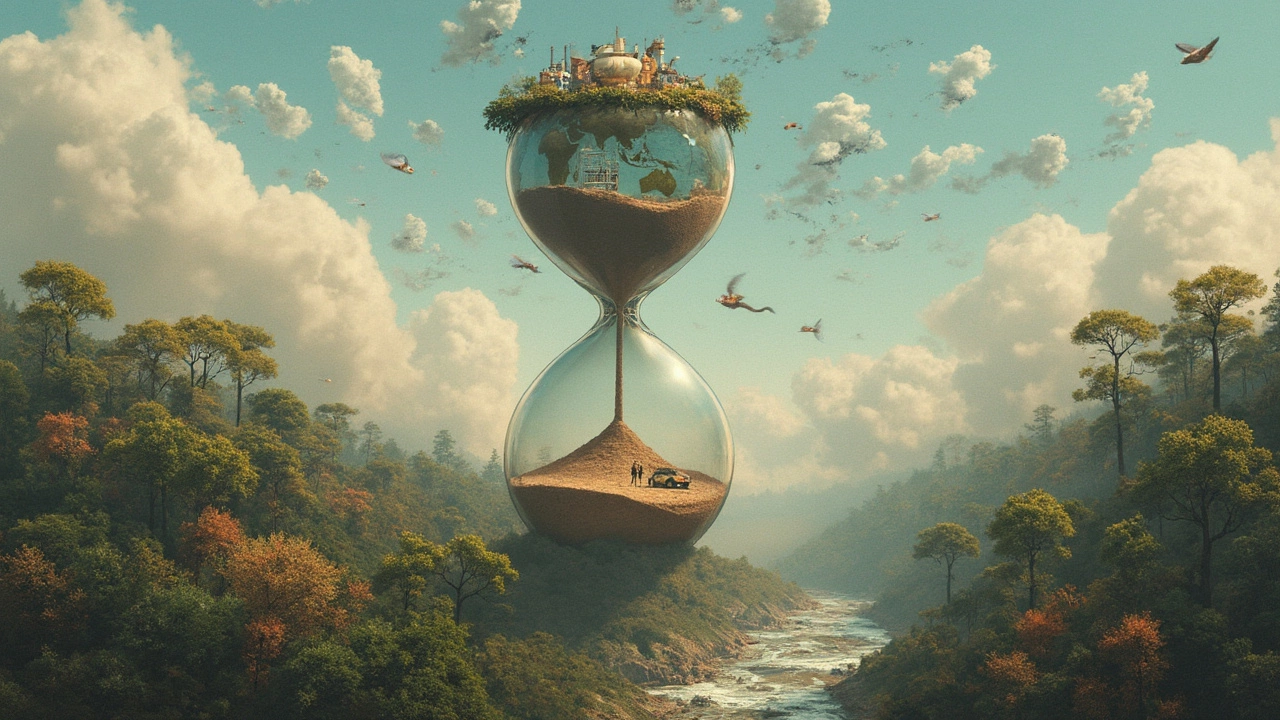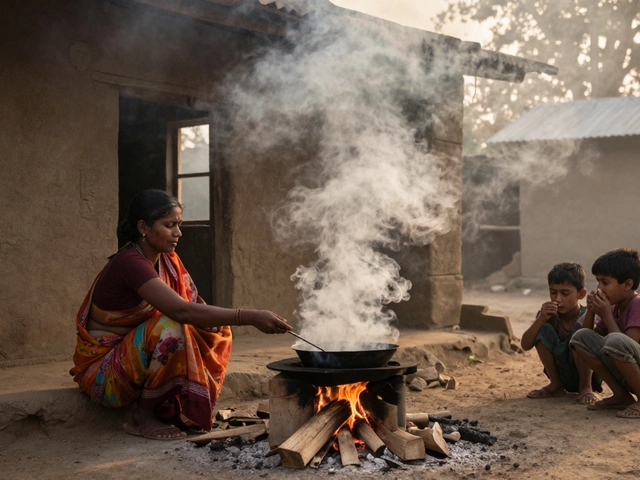Ever wondered how climate change and global warming are connected? Well, they are not just buzzwords making headlines; they are two sides of the same coin. Essentially, global warming is one of the major effects of climate change. So, when we talk about the planet heating up, it's directly tied to broader climate changes happening around us.
Here's the deal: greenhouse gases, like carbon dioxide and methane, trap heat in our atmosphere. This process is often referred to as the 'greenhouse effect,' and it's a natural occurrence. However, human activities—like burning fossil fuels and deforestation—are cranking up levels of these gases, amping up the effect way beyond natural levels.
Want to make a difference? Start by being mindful of energy consumption. Simple habits, like turning off lights when not in use or opting for public transport, can significantly cut down emissions. Every little effort counts when trying to tackle such a colossal challenge.
- Defining Climate Change and Global Warming
- The Science of Greenhouse Gases
- Human Activities and Their Impact
- Misconceptions and Myths
- Steps Towards Reduction
Defining Climate Change and Global Warming
So, what are climate change and global warming anyway? These terms get tossed around a lot, but they're not quite the same thing. Climate change includes not only global warming but also everything else that increasing greenhouse gas amounts will affect. It's all about long-term changes in the average weather we experience.
Now, let's break it down. Global warming refers specifically to the Earth's escalating surface temperatures. Think of it as the planet running a fever, with temperatures rising consistently since the late 19th century. It's too dramatic to overlook, considering the Earth's average temperature has risen by about 1.18 degrees Celsius since pre-industrial times.
A key player here is greenhouse gases, like carbon dioxide (CO2) and methane (CH4). These gases are responsible for trapping heat in our atmosphere. That wouldn't be a problem if it weren't for humans increasing those gases through activities like burning fossil fuels and chopping down forests.
The Role of Human Activities
Why should we care? Because human actions have cranked things up. The more fossil fuels we burn (like coal, oil, and natural gas), the more CO2 we release into the atmosphere, intensifying the natural greenhouse effect.
Can we put this into perspective? Imagine our atmosphere as an insulation blanket wrapped around the Earth. Extra greenhouse gases make this blanket thicker, trapping more heat and leading to higher temperatures.
Understanding the Impacts
Climate change manifests in various ways: erratic weather, rising sea levels, and even shifts in wildlife patterns. Scientists have observed these changes through meticulous data collection and analysis.
| Year | Global Average Temperature Increase (°C) |
|---|---|
| 1880 - 1899 | 0.00 |
| 1970 - 1979 | 0.44 |
| 2000 - 2009 | 0.79 |
| 2020 | 1.18 |
It's not just a warming issue; it’s reshaping our planet. Ice caps melting, extreme weather patterns escalating, and sea levels rising are real symptoms we're witnessing.
Understanding these distinctions and connections helps paint a picture of the challenge we're up against. While intimidating, it also gives us direction for meaningful solutions. So, keep this in mind as we unpack more about our climate's changes in the next sections!
The Science of Greenhouse Gases
Alright, let's break down what greenhouse gases are all about. Imagine a blanket around the Earth, keeping us warm. That's basically what these gases do, except now, the blanket is getting too thick thanks to human activities. This isn't your cozy comforter anymore—it's causing our planet's thermostat to rise, impacting global warming.
These gases include carbon dioxide (CO2), methane (CH4), and nitrous oxide (N2O). They occur naturally but, since the Industrial Revolution, humans have ramped up their levels big time. Burning fossil fuels for energy, cutting down forests, and industrial processes all pump extra amounts of these gases into the atmosphere.
The Role of Carbon Dioxide
Carbon dioxide comes from pretty much all our daily activities—driving cars, using electricity, and even making products like cement. It's the biggest contributor to the human-caused greenhouse effect. Fun fact: CO2 can linger in our atmosphere for hundreds of years, meaning it keeps warming the planet long after it's emitted.
Methane and the Beef Connection
Methane is shorter-lived than CO2 but over 25 times more effective at trapping heat. Agriculture plays a massive role here, with livestock like cows producing methane during digestion. Cow burps might sound funny, but they’re no joke when it comes to climate change.
| Greenhouse Gas | Global Warming Potential over 100 years |
|---|---|
| Carbon Dioxide (CO2) | 1 |
| Methane (CH4) | 25 |
| Nitrous Oxide (N2O) | 298 |
Finding Solutions
So, what can we do? Cutting emissions is key. Switching to renewable energy sources, improving energy efficiency, and adopting sustainable agricultural practices can make a significant difference. Plus, planting more trees helps absorb CO2, acting as nature's air purifier.
Understanding the science behind these gases and their impact is the first step in tackling the problem. The more we know, the better equipped we are to make informed choices that contribute to a healthier planet.

Human Activities and Their Impact
It's no secret that what we do on a daily basis plays a huge role in climate change and global warming. But how exactly do our actions tip the balance? Let's break it down.
Burning Fossil Fuels
The most significant contributor is burning fossil fuels for energy. Whether it’s coal, oil, or natural gas, the combustion process releases tons of carbon dioxide into the atmosphere. Power plants, cars, and manufacturing industries are big players here.
Deforestation
Forests act as carbon sinks, absorbing carbon dioxide. However, cutting down trees for agriculture or paper reduces this capacity. Plus, when trees are burned or decompose, the stored carbon is released back into the atmosphere. It's a double whammy!
Agricultural Practices
Agriculture might seem harmless, but livestock like cows emit methane during digestion. Fertilizers used on crops release nitrous oxide. Both are potent greenhouse gases that contribute to warming.
Waste Management
Ever thought about where your trash goes? Landfills release methane during waste decomposition. Poor waste management means more landfill sites and, consequently, more emissions.
| Human Activity | Contribution to CO2 Emissions |
|---|---|
| Burning Fossil Fuels | 65% |
| Deforestation | 11% |
| Agriculture | 14% |
| Waste Management | 3% |
Taking Action
- Reduce Energy Use: Switch to energy-efficient appliances and consider renewable energy sources like solar power.
- Plant Trees: Participate in tree-planting drives to offset carbon emissions.
- Change Diets: Consume less meat, which has a high carbon footprint.
- Recycle: Proper waste segregation reduces landfill contribution.
By understanding and addressing these factors, we can help mitigate the human impact on our planet’s climate. It's about making practical choices that collectively lead to significant change.
Misconceptions and Myths
When it comes to climate change and global warming, there's a fair bit of confusion floating around. Let's clear the air by tackling some common myths.
Myth 1: Climate Change is a Future Problem
Many folks think climate change is something far off in the future, but that's not the case. The effects are happening now, from rising sea levels to more frequent extreme weather. A report from the Intergovernmental Panel on Climate Change (IPCC) highlights that if we don't act now, consequences will get worse.
"Climate change is not a problem for our children's generation; it's our problem." - Dr. Jane Goodall, primatologist and anthropologist
Myth 2: It's Solely Due to Natural Causes
Some argue that current climate patterns are just natural cycles. While Earth does go through cycles, the crazy speed of recent changes is largely driven by human activities. NASA has data showing how much human impact is accelerating these changes.
Myth 3: It's Too Late to Make a Difference
Feeling defeated before we even start? It's never too late! Every small action helps. Whether it's conserving energy or supporting renewable resources, there's still time to turn the tide.
Myth 4: Cold Weather Disproves Global Warming
A cold snap doesn't mean global warming isn't real. Weather is different from climate, and warming refers to long-term trends, not short-term chills. In fact, extreme shifts—hot or cold—are signs of change.
Stats Corner: How Misunderstood is This?
| Myth | Pct. Believing |
|---|---|
| Climate Change is Natural | 45% |
| Actions Won't Make a Difference | 37% |
| Cold Weather = No Warming | 29% |
Education is key to dispelling these myths, so keep yourself informed and share the truth!

Steps Towards Reduction
So you're pumped to help fight climate change and tackle global warming? Awesome! Real change starts with small actions. Here’s what you can do:
Cutting Down on Fossil Fuels
Most of our energy comes from burning fossil fuels, which is a big no-no for the environment. Switching to renewable energy like solar or wind is a game changer. But if that's out of reach, you can still make an impact by using less energy at home. Try energy-saving bulbs, smart thermostats, or even just unplugging gadgets when they’re not in use.
Travel Smarter
Ever thought about how your daily commute is adding to the carbon footprint? Opt for public transportation, carpooling, or, better yet, biking or walking if possible. It’s not only eco-friendly but great for your health, too!
Sustainable Eating
The food industry plays a massive role in greenhouse gas emissions. Eating less meat, buying locally-produced foods, and reducing food waste can significantly lower your personal impact. Consider trying the plant-based diet; it’s more sustainable and quite trendy these days.
Recycle and Reuse
Before you toss something in the trash, think about recycling or repurposing it. Recycling helps cut down the energy used in manufacturing new products. A lot of stuff can have a second life; sometimes you just need to get creative!
Supporting Innovation
Support corporations and policies that are serious about reducing carbon footprints. Look for brands that prioritize sustainability and innovation. Your buying power makes a difference, so spend it wisely.
Making these adjustments might sound small, but they add up quickly. According to a recent study, households implementing these changes can cut their carbon footprint by up to 20%. That's huge! So go on, take the first step, and inspire others around you to join the cause.



